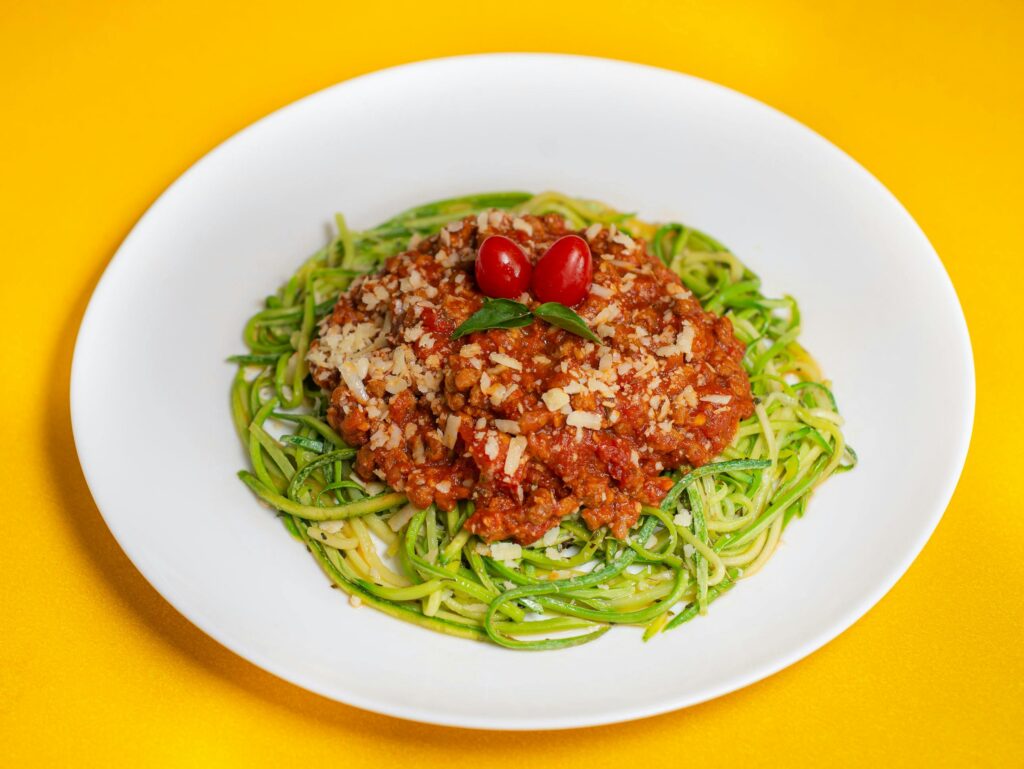Spaghetti squash, also known as vegetable spaghetti, is a winter squash variety characterized by its stringy flesh that resembles spaghetti noodles when cooked. This oval-shaped squash ranges in color from pale yellow to orange and is popular as a low-carbohydrate pasta alternative. When prepared, the flesh can be easily separated into strands using a fork, mimicking the appearance of spaghetti.
This vegetable is not only versatile in cooking but also nutritionally beneficial. Spaghetti squash is low in calories and carbohydrates, making it suitable for weight management and blood sugar control. It is high in fiber, which aids digestion and promotes satiety.
The squash also contains essential nutrients such as vitamin C, vitamin A, potassium, and manganese, contributing to overall health and well-being. Spaghetti squash’s mild, slightly sweet flavor and unique texture make it adaptable to various culinary applications. It can be used as a simple pasta substitute or incorporated into more complex dishes like casseroles and stir-fries.
This vegetable offers a nutritious option for those seeking to increase their vegetable intake or diversify their meal options.
Key Takeaways
- Spaghetti squash is a winter squash variety known for its stringy, noodle-like flesh when cooked.
- Spaghetti squash is low in calories and high in fiber, making it a great option for those looking to add more vegetables to their diet.
- Spaghetti squash can be cooked by roasting, boiling, microwaving, or using a slow cooker.
- Spaghetti squash carbonara is a delicious and healthy alternative to traditional pasta carbonara.
- Spaghetti squash primavera is a colorful and flavorful dish that can be customized with your favorite vegetables and herbs.
- Spaghetti squash with tomato basil sauce is a simple and satisfying meal that can be topped with cheese or protein for added flavor.
- To incorporate spaghetti squash into your dinner rotation, try using it as a base for stir-fries, salads, or as a side dish with your favorite protein.
Nutritional Benefits of Spaghetti Squash
Nutrient-Rich and Low in Calories
This versatile vegetable is low in calories and carbohydrates, making it an excellent choice for those looking to manage their weight or blood sugar levels. Additionally, spaghetti squash is a good source of fiber, which is important for digestive health and can help promote feelings of fullness and satiety.
Supporting Heart Health
Fiber also plays a crucial role in supporting heart health by helping to lower cholesterol levels and reduce the risk of heart disease. In addition to its fiber content, spaghetti squash is rich in vitamins and minerals that are essential for overall health and well-being.
A Rich Source of Vitamins and Minerals
Spaghetti squash is a good source of vitamin C, which is important for immune function and skin health, as well as vitamin A, which is crucial for vision and immune function. It also provides potassium, a mineral that helps regulate blood pressure and support proper muscle and nerve function, and manganese, which is important for bone health and metabolism.
How to Cook Spaghetti Squash

Cooking spaghetti squash is relatively simple and can be done using a few different methods. One popular way to cook spaghetti squash is by roasting it in the oven. To do this, start by preheating your oven to 400°F.
Next, carefully cut the spaghetti squash in half lengthwise and scoop out the seeds and stringy pulp from the center. Place the squash halves cut-side down on a baking sheet and roast in the oven for 40-50 minutes, or until the flesh is tender and easily pierced with a fork. Once cooked, use a fork to scrape out the flesh, separating it into long strands that resemble spaghetti noodles.
Another method for cooking spaghetti squash is by using a microwave. To do this, carefully pierce the whole squash with a sharp knife in several places to allow steam to escape during cooking. Place the squash on a microwave-safe dish and microwave on high for 10-12 minutes, or until the skin can be easily pierced with a fork.
Let the squash cool for a few minutes before cutting it in half lengthwise and removing the seeds and stringy pulp. Use a fork to scrape out the flesh into long strands. No matter which method you choose, cooking spaghetti squash is a simple and versatile way to enjoy this nutritious vegetable as a pasta alternative or as a delicious side dish.
Spaghetti Squash Carbonara Recipe
Spaghetti squash carbonara is a delicious and satisfying dish that puts a healthy twist on the classic Italian pasta dish. To make spaghetti squash carbonara, start by roasting a spaghetti squash in the oven until tender. While the squash is roasting, cook diced bacon in a skillet until crispy, then remove it from the pan and set it aside.
In the same skillet, sauté minced garlic until fragrant, then add cooked spaghetti squash strands to the pan and toss to combine. In a separate bowl, whisk together eggs, grated Parmesan cheese, salt, and pepper. Pour the egg mixture over the spaghetti squash in the skillet and toss everything together until the eggs are cooked and the sauce is creamy.
Add the cooked bacon back into the skillet and stir to combine. Serve the spaghetti squash carbonara with an extra sprinkle of Parmesan cheese and chopped fresh parsley for a delicious and nutritious twist on a classic comfort food.
Spaghetti Squash Primavera Recipe
Spaghetti squash primavera is a colorful and flavorful dish that features an assortment of fresh vegetables and herbs. To make spaghetti squash primavera, start by roasting a spaghetti squash in the oven until tender. While the squash is roasting, sauté an assortment of colorful vegetables such as bell peppers, zucchini, cherry tomatoes, and spinach in a skillet with olive oil and minced garlic until tender-crisp.
Once the spaghetti squash is cooked, use a fork to scrape out the flesh into long strands and add it to the skillet with the sautéed vegetables. Toss everything together with fresh basil, oregano, salt, and pepper for added flavor. Serve the spaghetti squash primavera with a sprinkle of grated Parmesan cheese and a drizzle of balsamic glaze for a vibrant and satisfying meal that’s packed with nutritious vegetables.
Spaghetti Squash with Tomato Basil Sauce Recipe

Roasting the Spaghetti Squash
To start, roast a spaghetti squash in the oven until it’s tender. This will bring out the natural sweetness of the squash and make it easy to work with.
Preparing the Tomato Basil Sauce
While the squash is roasting, prepare a homemade tomato basil sauce. Sauté diced onions and minced garlic in olive oil until they’re softened, then add canned crushed tomatoes, fresh basil, oregano, salt, and pepper to the skillet. Simmer the sauce for 15-20 minutes, allowing the flavors to meld together and the sauce to thicken slightly.
Assembling and Serving
Once the spaghetti squash is cooked, use a fork to scrape out the flesh into long strands. Toss the squash with the homemade tomato basil sauce, then serve with an extra sprinkle of fresh basil and grated Parmesan cheese. This simple yet satisfying meal is bursting with fresh flavors and is sure to become a new favorite.
Tips for Incorporating Spaghetti Squash into Your Dinner Rotation
Incorporating spaghetti squash into your dinner rotation is a great way to add variety to your meals while also reaping the nutritional benefits of this versatile vegetable. One easy way to enjoy spaghetti squash is by using it as a pasta substitute in your favorite recipes. Whether you’re making spaghetti carbonara, primavera, or marinara, swapping traditional pasta for spaghetti squash can help reduce your carbohydrate intake while adding more fiber and nutrients to your meal.
Another way to incorporate spaghetti squash into your dinner rotation is by using it as a base for hearty casseroles or stir-fries. Layer cooked spaghetti squash with sautéed vegetables, lean protein such as chicken or turkey, and your favorite seasonings for a satisfying one-dish meal that’s packed with flavor and nutrition. Additionally, you can use leftover cooked spaghetti squash as a base for breakfast dishes such as frittatas or egg scrambles.
Simply reheat the spaghetti squash in a skillet or microwave and top it with scrambled eggs, diced vegetables, and shredded cheese for a quick and nutritious morning meal. Overall, incorporating spaghetti squash into your dinner rotation is an easy way to add more vegetables to your diet while enjoying delicious and satisfying meals that are packed with essential nutrients. Whether you’re looking to reduce your carbohydrate intake or simply switch up your meal routine, spaghetti squash is a versatile and nutritious option to consider.
FAQs
What is spaghetti squash?
Spaghetti squash is a type of winter squash that, when cooked, can be shredded into strands that resemble spaghetti noodles.
How many carbs are in spaghetti squash?
One cup of cooked spaghetti squash contains about 10 grams of carbohydrates.
Is spaghetti squash a healthy choice for a low-carb diet?
Yes, spaghetti squash is a great option for those following a low-carb diet, as it is lower in carbohydrates compared to traditional pasta.
What are the health benefits of spaghetti squash?
Spaghetti squash is a good source of fiber, vitamins, and minerals. It is also low in calories and can be a good substitute for higher-carb foods like pasta.
How can spaghetti squash be prepared?
Spaghetti squash can be roasted, boiled, or microwaved. Once cooked, the flesh can be scraped out with a fork to create spaghetti-like strands.
Can spaghetti squash be used as a substitute for pasta in recipes?
Yes, spaghetti squash can be used as a healthy alternative to pasta in a variety of dishes, such as spaghetti squash with marinara sauce or as a base for a stir-fry.


